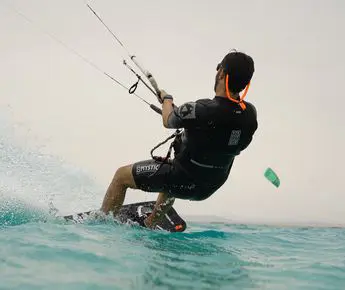
How to Start Kiteboarding

Kiteboarding, also known as kite surfing, is an exhilarating sport that combines elements of surfing, windsurfing, and paragliding. It’s a fantastic way to experience the thrill of riding on water while being propelled by the wind. If you’ve ever been fascinated by the idea of harnessing the wind to glide across the waves, kiteboarding might just be the perfect adventure for you. Here’s a comprehensive guide on how to get started with kiteboarding, from choosing the right gear to taking your first flight.
Kiteboarding involves riding a board while being pulled by a kite through the power of the wind. The kite is controlled by a set of lines connected to a bar, which you hold onto. The harness, which you wear around your waist, is attached to the kite via a spreader bar. This setup allows you to use the wind’s power to move across the water, perform tricks, and experience the joy of flight.
Kite
The kite is the most crucial piece of equipment in kiteboarding. Kites come in various sizes and shapes, each designed for different wind conditions and skill levels. Beginners typically start with a larger, more stable kite that provides a steady pull and is easier to control. As you progress, you can experiment with different sizes and types of kites based on your needs and the conditions.
Board
Kiteboarding boards come in various shapes and sizes, including twin-tips (which can be ridden forwards or backwards), directional boards (designed for riding waves), and foil boards (for smoother rides). Twin-tips are the most common choice for beginners due to their versatility and ease of use.
Harness
The harness connects you to the kite and helps transfer the kite’s pull from your arms to your body. There are two main types: seat harnesses (which are worn like a pair of shorts) and waist harnesses (which sit around your waist). Most beginners start with a seat harness as it offers more support and comfort.
Other Gear
In addition to the main equipment, you’ll need a few additional items:
Control Bar and Lines: Used to steer the kite and manage its power.
Wetsuit: Provides warmth and protection from the elements, especially in colder waters.
Helmet and Impact Vest: Essential for safety, protecting your head and torso in case of falls or collisions.
Kiteboarding is a sport that requires proper technique and safety knowledge. It’s highly recommended to take lessons from a certified instructor to learn the fundamentals and ensure a safe and enjoyable experience. Professional instructors will guide you through:
Kite Control: How to launch, steer, and land the kite.
Safety Procedures: How to handle emergency situations and use safety systems.
Water Techniques: How to ride, turn, and maneuver on the board.
Safety is paramount in kiteboarding. Here are some essential safety tips:
Understand the Wind Conditions: Learn to read wind patterns and know when it’s safe to kiteboard.
Check Equipment: Always inspect your gear before each session for any signs of wear or damage.
Know Your Limits: Start in small, manageable conditions and gradually build up as your skills improve.
Follow Local Regulations: Abide by local kiteboarding rules and guidelines to ensure safety for yourself and others.
Before hitting the water, practice controlling the kite on land. This will help you get a feel for the kite’s power and responsiveness. Most kiteboarding schools offer land-based training, which includes:
Kite Handling: Learning how to control the kite, including steering and managing power.
Body Dragging: Practicing how to move through the water while being pulled by the kite without using the board.
Once you’re comfortable with kite control on land, it’s time to take your skills to the water. Begin in shallow, calm conditions where you can easily stand up and practice:
Launching and Landing: Learn how to safely launch and land the kite in the water.
Water Starts: Practice getting up on the board and starting to ride.
Basic Maneuvers: Start with simple turns and gradually progress to more advanced techniques.
Kiteboarding is a sport that offers endless opportunities for progression. As you gain experience and confidence, you can start experimenting with different tricks, riding in various conditions, and exploring new spots. Joining a kiteboarding community or club can also provide valuable support, advice, and camaraderie.
Kiteboarding is not just about the technical aspects; it’s also about having fun and enjoying the freedom of riding on the water. Take the time to appreciate the experience, embrace the challenges, and celebrate your progress.
Starting kiteboarding is an exciting journey that combines the thrill of adventure with the joy of mastering a new skill. By choosing the right equipment, getting professional instruction, following safety guidelines, and practicing diligently, you’ll be well on your way to soaring across the water and experiencing the exhilaration of kiteboarding. So gear up, hit the water, and let the wind guide you to new heights!
